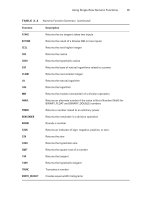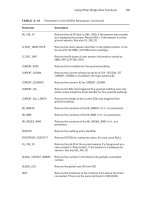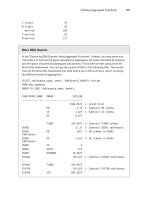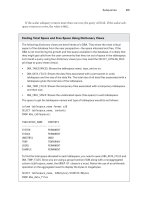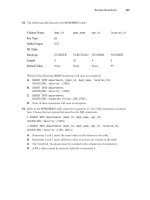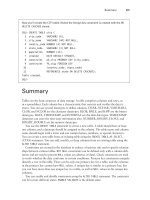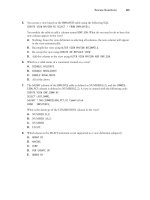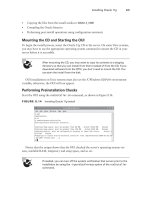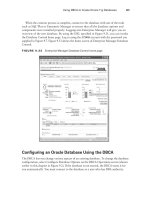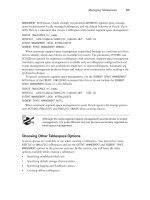Tài liệu Virtualizing Oracle Database 10g/11g on VMware Infrastructure docx
Bạn đang xem bản rút gọn của tài liệu. Xem và tải ngay bản đầy đủ của tài liệu tại đây (1.39 MB, 42 trang )
Virtualizing Oracle Database 10g/11g on VMware
Infrastructure
Consolidation Solutions with VMware
®
Infrastructure 3
and EMC Celerra NS40 Multi-Protocol Storage
May 2009
VMware Inc. Virtualizing Oracle Database 10g/11g on VMware Infrastructure
Technical White Paper ii
Contents
Executive Overview 1
Introduction 1
Related Documents and Resources 1
Commercial Publications 1
VMware Resources 2
EMC Publications 2
Oracle Support 2
Business Challenges 4
Virtualization Technology Solution 4
Consolidation with VMware Infrastructure versus Oracle RAC 5
Simplified High Availability 5
Simplified Project Consolidation 7
Reduced Oracle Licensing Costs 8
Improved Performance 8
Solution Components 10
VMware Infrastructure 10
Oracle Database 10g/11g 12
EMC Celerra NS Series Storage 12
Solution Architecture 13
Configuration 1 – Oracle Database on VMware Infrastructure Using a Pure NFS Storage Design 14
VMware Architecture 16
Storage Architecture 17
Configuration 2 – Oracle Database on VMware Infrastructure Using a Pure NFS Storage Design with a
Four-Node VMware HA/DRS Cluster Solution 18
VMware Architecture 20
Storage Architecture 21
Configuration 3 – Oracle Database on VMware Infrastructure Using Blended FCP/NFS Storage Design 22
VMware Architecture 24
Storage Architecture 25
Conclusion 26
Appendix A. Oracle Solution Features and Capabilities 27
Appendix B. Storage Layouts for Pure NFS Configuration 28
VMware Inc. Virtualizing Oracle Database 10g/11g on VMware Infrastructure
Technical White Paper iii
Appendix C. Storage Layouts for Blended NFS/FCP Configuration 33
Appendix D. Hardware and Software Resources 37
Hardware Resources 37
Software Resources 38
VMware Inc. Virtualizing Oracle Database 10g/11g on VMware Infrastructure
Technical White Paper 1
Executive Overview
This document describes the configuration of three different solutions for virtualizing Oracle
database servers on VMware® Infrastructure and EMC Celerra storage. These solutions enable
enterprises to take a number of their departmental databases and consolidate them on to a
smaller number of servers, thereby reducing administrative requirements, simplifying end-user
access and control, and reducing overall system costs associated with complex Oracle
environments. Once virtualized, Oracle databases can reap all the benefits of a virtualized
platform. These benefits include rapid database server provisioning, simplified high availability
and disaster recovery, reduced server hardware requirements and associated costs such as power,
cooling, and rack space.
Introduction
This document is intended to provide customers with technical solution and configuration
information that can be used as the basis for virtualizing Oracle database servers on the VMware
Infrastructure platform. The specific solutions described in this document are the following:
1. Oracle Database on VMware Infrastructure using a pure NFS storage design (on a single
VMware® ESX host).
2. Oracle Database on VMware Infrastructure using a pure NFS storage design with a four-node
VMware® High Availability (HA)/VMware® Distributed Resource Scheduler (DRS) cluster
solution (using multiple ESX servers).
3. Oracle Database on VMware Infrastructure using a blended FCP/NFS storage design (on a
single ESX server).
Details are provided for the ESX server and virtual machine configurations as well as Celerra disk
storage layouts for the three different configurations. Testing was also done to demonstrate how
each of these configurations can provide capabilities for backup, disaster recovery and test/dev.
Readers should have a thorough understanding of storage, virtualization and Oracle database
concepts to get the most value from this document.
All solution design and testing was done at EMC labs in Raleigh, North Carolina in conjunction
with VMware.
Related Documents and Resources
Documents listed here provide additional information relevant to the topics described in this
document.
Commercial Publications
• Scalzo, Bert. Oracle on VMware: Expert Tips for Database Virtualization. Kittrell, NC: Rampant
Techpress, 2008.
VMware Inc. Virtualizing Oracle Database 10g/11g on VMware Infrastructure
Technical White Paper 2
VMware Resources
The VMware website for Oracle virtualization (www.vmware.com/oracle) contains a number of
different informational resources for customers interested in virtualizing Oracle database
applications. These resources include customer case studies, demos, whitepapers and
performance studies:
• Whitepaper – Oracle Database Scalability on VMware ESX
/>
• Whitepaper – Simplify Oracle Database Management with VMware Infrastructure 3 and
EMC CLARiiON Storage:
/>
• Whitepaper – Eliminating Oracle Planned Downtime with VMware® VMotion:
/>
• Webcast – Oracle Database Performance on VMware Infrastructure:
/>
• VMware Blog Post – Performance study: 100,000 Oracle I/O Operations Per Second, One ESX Host:
/>
• VMware Blog Post – Ten Reasons Why Oracle Databases Run Best on VMware Infrastructure:
/>
• Customer Success Stories:
/>
EMC Publications
The following technical papers are available on the EMC.com and EMC Powerlink websites:
• Reference Architecture: EMC Solutions for Oracle Database 10g/11g for Midsize Enterprises—
Virtualized Solutions EMC Celerra NS40 Unified Storage Platform
• White Paper: EMC Solutions for Oracle Database 10g/11g for Midsize Enterprises—EMC Celerra
Unified Storage Platform - Applied Technology Guide
• White Paper: EMC Solutions for Oracle Database 10g/11g for Midsize Enterprises —EMC
Celerra Unified Storage Platform - Best Practices Planning
Note that access to these documents is based on your login credentials. If you do not have
access, contact your EMC representative.
Oracle Support
Oracle provides support on using VMware Infrastructure as described in the Oracle Metalink
document, Number 249212.1.
VMware Inc. Virtualizing Oracle Database 10g/11g on VMware Infrastructure
Technical White Paper 3
EMC supported configurations for deploying Oracle software (and associated operating systems)
on EMC storage hardware and software can be found within EMC’s eLab Navigator, available
through the EMC PowerLink website.
VMware Inc. Virtualizing Oracle Database 10g/11g on VMware Infrastructure
Technical White Paper 4
Business Challenges
Enterprises today face a number of challenges when it comes to managing Oracle database
environments. These include:
• Increased end-user demand for on-demand, always-on access to databases and analytics.
• Requirements to support a fragmented environment consisting of multiple departmental
servers running different versions of Oracle database and operating systems.
• Rising administrative costs to support this heterogeneous database environment.
• Rising data center costs (power, cooling, floor space, etc.) due to server sprawl.
• Under-utilization of server computing resources.
• Lack of sufficient IT resources to deploy, manage, and maintain complex Oracle database
environments at the departmental level.
• Requirements for a simple and affordable consolidation solution of Oracle database servers.
Customers looking to reduce the cost and complexity of their Oracle database server
environment are increasingly looking to server virtualization to address the challenges listed
above. Oracle databases are mission critical for most organizations which makes designing a
consolidated solution that reduces costs while increasing overall availability very challenging.
Virtualization Technology Solution
Pertaining to Oracle virtualization, the solutions described in this document address a number of
the challenges listed above:
• For organizations that need to support different departments, each running different versions
of database and application software, virtual machines provide an ideal way to maintain
isolation of different configurations by deploying each configuration in its own independent
virtual machine. These independent virtual machines can then be consolidated on fewer host
servers for cost efficiency, while maintaining complete isolation from each other.
• When Oracle database servers are consolidated on VMware Infrastructure, customers can
immediately obtain benefits from the high availability features provided by the VMware
platform. For enterprise Oracle deployments, VMware high availability features such as
VMware VMotion and VMware HA can provide sufficient levels of availability at a fraction of
the cost and complexity of traditional cluster solutions such as Oracle RAC.
• Consolidating Oracle database servers using VMware virtual machines can reduce server
sprawl and reduce infrastructure costs. The configurations presented in this document
demonstrate solutions for consolidation using a single ESX server and how this can scale up
to multiple ESX servers for larger environments.
• Running multiple Oracle database virtual machines on the same physical servers can increase
the CPU and memory utilization of servers, from what is commonly less than 10%, to upwards
of 65% or more, delivering an improved ROI on server hardware capital investments.
VMware Inc. Virtualizing Oracle Database 10g/11g on VMware Infrastructure
Technical White Paper 5
• Consolidated virtual infrastructure results in improved server-to-admin ratios. Tasks such as
database server provisioning, migrating applications onto newer hardware, and server
hardware maintenance can be reduced from days/hours on physical servers to a matter of
minutes on virtual systems.
Consolidation with VMware Infrastructure versus Oracle RAC
For enterprise customers evaluating solutions for Oracle database consolidation, the typical
recommendation presented by Oracle has been to move many databases into a single, multi-
node Oracle RAC implementation. This option works and is well-understood—both the benefits
of that effort, as well as the real license and implementation costs associated with this means of
database consolidation. However, the process required to move to an Oracle RAC implementation
can be very time consuming and complicated, especially in environments that contain large
numbers of heterogeneous Oracle database servers (operating system, database versions,
applications). As an alternative to the solution using Oracle RAC, consider the approach using
VMware virtualization. The VMware approach differs from RAC, and is not an apples-to-apples
comparison, but can achieve most of the goals of a RAC solution, with substantial cost and time-
to-deployment benefits that are outlined below.
Simplified High Availability
A key issue with consolidation is database availability. With consolidation to a single instance
(RAC), clearly uptime is critical. Any offline condition would impact all users. RAC solves this
problem with continuous availability and is well-suited for that condition. In the VMware
approach, each database remains independent (multiple instances) and any one database failure
or even host failure (impacting the databases running on that machine) will impact a limited
number of the total user base. With VMware HA, the databases impacted by a server failure are
brought back online within minutes, automatically restarted on another ESX server using VMware
HA.
Table 1 compares the high availability approach used by VMware Infrastructure to a solution
using Oracle RAC.
Table 1. VMware High Availability and Oracle RAC Approaches
Feature/Functionality RAC VMware HA Cluster
Failover Real-time HA w/ continuous
database uptime (some loss of
connectivity may occur)
Transparent failover for planned
downtime using VMotion, but
unplanned hardware failure requires
reboot (guaranteed loss of
connectivity while virtual machine
reboots)
Data visibility Scale-up single database image (e.g. ,
one monolithic application)
Scale-out many single database
instances (e.g., software as a service
or database cloud)
VMware Inc. Virtualizing Oracle Database 10g/11g on VMware Infrastructure
Technical White Paper 6
The VMware approach provides high availability protection for both planned and un-planned
downtime using VMware VMotion and VMware HA.
• Unplanned downtime due to server hardware failure: In the event of server hardware
failure, VMware HA will restart Oracle virtual machines on a surviving ESX host server.
Downtime is encountered as the virtual machines restarts, which is typically measured in
minutes in most environments.
Figure 1. Protection from server hardware failure with VMware HA
• Planned downtime: During planned downtime, Oracle database virtual machines can be
migrated online at any time to another ESX server, with no loss of service, using VMware
vMotion. VMotion can be especially useful when migrating Oracle databases onto newer
hardware during server refresh cycles, in hardware troubleshooting scenarios, and managing
changes in hardware maintenance windows. All of these can be accomplished with no
downtime using VMotion.
Figure 2. Using VMware VMotion to avoid planned downtime
VMware Inc. Virtualizing Oracle Database 10g/11g on VMware Infrastructure
Technical White Paper 7
Most departmental databases can tolerate the minimal downtime associated with VMware HA
and a reboot of virtual machines. However, it is important that Oracle database administrators
understand the trade-offs between both approaches (Oracle RAC and VMware HA/vMotion) and
choose a solution that meets their SLAs. The configurations presented later in this document have
all been designed and tested using VMware Infrastructure to provide high availability.
Simplified Project Consolidation
Many organizations currently find themselves supporting a wide range of departmental Oracle
database servers, running a wide range of Oracle database versions (everything from 8i to 11g) on
a wide range of operating systems (multiple different versions of Windows and Linux as well as
Solaris-x86). The approach with Oracle RAC means that all of these database servers (and the
applications they support) need to first be upgraded to run on a single version of Oracle database
on a single operating system as part of the RAC implementation. The time, cost, complexity, and
risk associated with migrating all of these independent servers can be a major barrier to
successful, cost-effective consolidation.
Using the VMware approach to Oracle database consolidation allows each database server to
remain on its current version of Oracle database and its current operating system. There are no
database or operating system migrations to worry about and virtualizing database servers can be
as simple as using the free VMware vCenter Converter
1
product to convert a system from a
physical machine to a virtual machine running on VMware Infrastructure. Downtime is minimized
and each department can continue to maintain its own independent operating system and
database instance. Each database can be managed individually in terms of backup/recovery,
disaster recovery, patches and upgrades, and test/dev. Figure 3 shows a single VMware ESX server
running four Oracle database servers, each running its own version of Oracle database and its
own operating system.
1
ForsupportedoperatingsystemswithVMwarevCenterConverter,pleasesee
/>
VMware Inc. Virtualizing Oracle Database 10g/11g on VMware Infrastructure
Technical White Paper 8
Figure 3. Consolidating heterogeneous Oracle database servers
on VMware Infrastructure
Reduced Oracle Licensing Costs
The VMware Infrastructure approach shown in Figure 3, where each Oracle database instance is
deployed in its own virtual machine, allows organizations to use the Oracle licenses they already
own for each database server. The Oracle RAC approach for consolidation requires upgrading to
Oracle RAC Enterprise Edition licenses. This can substantially increase the overall cost of the
solution and should be carefully weighed when considering a solution for database consolidation.
Improved Performance
Using the VMware HA cluster approach can actually improve overall Oracle database performance
in terms of transactions-per-second (TPS) for a given number of users, while decreasing the
overall software license costs per TPS. Figure 4 shows results of performance testing done using
an industry standard OLTP workload (Quest Benchmark factory) comparing a 4-node RAC cluster
to a 4-node VMware HA cluster
2
.
2
4-node cluster w/ Dell PE2900 servers, each with 2 x 2.66 GHz quad-core Intel Xeon x86-64, 24 GB RAM per node (96
GB total). Eight virtual machines on VMware HA Cluster versus four instances on RAC physical (OLTP workload using
Quest BMF).
VMware Inc. Virtualizing Oracle Database 10g/11g on VMware Infrastructure
Technical White Paper 9
Figure 4. Typical Database Performance (TPS and Users)
Figure 5. Typical License Costs Per TPS
Running multiple, independent Oracle database virtual machines delivers additional efficiencies
over a similar RAC configuration. Overheads associated with RAC in areas such as cache fusion
and block pinging are not encountered when using the VMware approach. Additionally, the
kernel parameters in /etc/sysctl.conf create hard limits per OS image in a RAC implementation,
while the VMware approach creates multiple copies of these limits.
VMware Inc. Virtualizing Oracle Database 10g/11g on VMware Infrastructure
Technical White Paper 10
Solution Components
All the solutions described in this document use a platform built using VMware Infrastructure,
Oracle Database 10g/11g, and EMC Celerra NS Series Storage.
VMware Infrastructure
In the configurations described in this document, virtualization of all database servers is
implemented using the VMware Infrastructure platform.
Enterprise Network
Enterprise Storage
Figure 6. VMware Infrastructure Components
Figure 6 shows the typical components used in a VMware Infrastructure design. VMware
Infrastructure is the most widely deployed production virtualization and management platform in
the industry. VMware Infrastructure includes the following:
• A high performance hypervisor.
VMware Inc. Virtualizing Oracle Database 10g/11g on VMware Infrastructure
Technical White Paper 11
• A distributed file system optimized for virtual machines (VMFS).
• A multi-virtual CPU sub-system (VSMP) that allows vertical scaling of loads as well as the
higher level functionality that use the above as a base.
Additional VMware Infrastructure features include:
• VMware® vCenter Management server – provides a management interface to all ESX hosts and
virtual machines.
• VMware VMotion and DRS – allow dynamic re-balancing of virtual machine loads across
clusters of ESX servers without human intervention.
• VMware High Availability (HA) – provides the capability of automatically re-starting virtual
machines and applications after a hardware failure in one ESX host.
These and several other technical features provide a robust virtualization platform for enterprise
software like Oracle databases that is in use at many customer sites today.
In the configurations described in this document for virtualizing Oracle database on VMware
Infrastructure, the following components were used in the lab for testing:
• Enterprise Storage:
- EMC Celerra NS-series and EMC CLARiiON CX series storage arrays
• Enterprise Network:
- Enterprise class network (1 GB) and Fibre Channel storage (4GB) switches
• Enterprise Servers:
- Enterprise class x86 servers
- Dual socket quad-core at 2.66 GHz
- 24GB RAM
• ESX Server:
- All testing was done using ESX Server 3.5.0 (Build 646072)
• Virtual Machines:
- All Oracle database virtual machines were running Oracle Enterprise Linux v5.2.
- Oracle database 10g/11g Standard Edition.
• vCenter:
- vCenter version 2.5 was deployed in the test lab on a stand-alone system. This system can
be deployed as either a stand-alone physical server or in a virtual machine.
• VMware DRS/VMotion/HA:
- VMware HA is used to provide high availability for the Oracle database virtual machines.
- VMware VMotion was used to migrate live, running database virtual machines across ESX
servers.
VMware Inc. Virtualizing Oracle Database 10g/11g on VMware Infrastructure
Technical White Paper 12
Oracle Database 10g/11g
Oracle is currently the dominant enterprise-class database software product on the market.
Analyst market share studies demonstrate that Oracle has the largest market share percentage of
any of the vendors in the same category. As Oracle provides a very reliable, robust, and
manageable product, VMware remains committed to creating solutions based upon the Oracle
database software stack.
The goal of the solutions presented in this document is to provide comprehensive testing,
validation, and documentation of complete environment configurations that
• include the Oracle software stack.
• are enabled by EMC storage hardware, EMC value-added software and VMware Infrastructure.
The Oracle software stack covered by the solutions consists of the following:
• Oracle Enterprise Linux
• Cluster Ready Services (CRS)
• Oracle Database
• Automatic Storage Management (ASM)
EMC Celerra NS Series Storage
Storage hardware used in the solutions described in this document is provided by the EMC®
Celerra® NS Series multi-protocol storage array. Celerra includes a Network Attached Storage
(NAS) array combined with the functionality and high performance of a Storage Area Network
(SAN) array. Celerra provides:
• NAS through the Network File System (NFS) and Common Internet File System (CIFS)
protocols
• iSCSI storage through the Celerra's Data Movers
• SAN storage over the Fibre Channel Protocol (FCP) through the back-end EMC CLARiiON® CX3-
40f series storage array
This document describes three different approaches for accessing all storage elements in a
virtualized Oracle database solution:
1. Pure NFS – All of the storage elements are accessed using the NFS protocol.
2. Pure NFS with VMware High Availability cluster – All of the storage elements are accessed
using the NFS protocol, but incorporating a four-node VMware High Availability (HA) cluster.
3. Blended FCP/NFS – The high-demand, low-latency storage elements of Oracle database
servers are accessed using Fibre Channel Protocol (FCP) and Oracle ASM. These data elements
include data files, online redo log files, control and temp files. All other storage elements are
accessed using the NFS protocol. These include flashback recovery area, archive logs, disk-
based backups, and CRS files.
VMware Inc. Virtualizing Oracle Database 10g/11g on VMware Infrastructure
Technical White Paper 13
Solution Architecture
The next sections describe the configuration of VMware Infrastructure, EMC Celerra NS Series
storage and Oracle database 10g/11g components for the three solutions presented in this
document:
• Configuration 1 – Oracle on VMware Infrastructure using a pure NFS storage design (single
ESX server).
• Configuration 2 – Oracle on VMware Infrastructure using a pure NFS storage design with a
four-node VMware HA/DRS cluster solution (multiple ESX servers).
• Configuration 3 – Oracle on VMware Infrastructure using a blended FCP/NFS storage design
single ESX server).
Each section also describes specific features that were tested to provide advanced functionality
for the Oracle database virtual machines. All configurations were tested for performance and
functionality at EMC labs - RTP in Raleigh, North Carolina in conjunction with VMware.
VMware Inc. Virtualizing Oracle Database 10g/11g on VMware Infrastructure
Technical White Paper 14
Configuration 1 – Oracle Database on VMware Infrastructure Using a Pure
NFS Storage Design
The first configuration is illustrated in Figure 7 below and represents a basic consolidation
scenario of four Oracle database servers on a single ESX host and the associated storage layout.
Primary storage is hosted on an EMC Celerra array using NFS for all Oracle database components.
Figure 7. Oracle Database on VMware Infrastructure Using a Pure NFS Storage
Design
VMware Inc. Virtualizing Oracle Database 10g/11g on VMware Infrastructure
Technical White Paper 15
Table 2 describes the solution features that have been validated for the pure NFS virtualized
solution. For a detailed description of the solution features listed, see Appendix A.
Table 2. Pure NFS Validated Solution Features
Solution Feature Details
Scale-Out OLTP Performance was tested in EMC labs using an industry-standard OLTP
database performance benchmark.
Basic Backup and Recovery Oracle Recovery Manager (RMAN) provides Basic Backup to the primary Celerra
storage array.
Advanced Backup and
Recovery
EMC Celerra SnapSure™ checkpoints were tested for advanced backup
functionality.
Basic Protect Oracle Recovery Manager (RMAN) to seed DR solution.
Oracle Data Guard to standby virtual machine and secondary Celerra array.
Resiliency Every significant layer of the solution has been tested by introducing faults.
Test/dev EMC Celerra SnapSure writeable checkpoints to a virtualized single-instance
target.
VMotion VMware VMotion was used to move live Oracle virtual machines from primary
ESX host to secondary ESX host while subjected to load testing.
VMware Inc. Virtualizing Oracle Database 10g/11g on VMware Infrastructure
Technical White Paper 16
VMware Architecture
This configuration presents a single ESX server for basic database consolidation. The physical ESX
server was a standard 2U x86 server with eight processor cores and 24 GB RAM. Performance and
functionality testing was done using a total of four Oracle database virtual machines running on
the ESX server.
Each virtual machine was allocated 7 GB of memory and two virtual CPUs. While initially this
required 28GB of RAM to be allocated to the virtual machines (four virtual machines with 7GB
RAM each), the ESX transparent page sharing mechanism was able to eliminate common memory
pages on the ESX server and total memory consumption was reduced to 24GB within minutes of
powering up all four virtual machines.
Figure 8. Virtual Machine Configuration on ESX Server
The specific configuration of the ESX server is the following:
• The ESX server is running ESX 3.5 (Build 646072).
• The ESX server is configured with 8 CPUs (2 x quad-core) and 24GB RAM.
The configuration of virtual machines is the following:
• Four database server virtual machines are created on a single ESX server.
• Each virtual machine is allocated 7 GB of memory and 2 vCPUs.
• Oracle Database 10g or 11g for x86 64-bit (SMP Kernel) is run on Oracle Enterprise Linux in all
the virtual machines shown in Figure 8.
VMware Inc. Virtualizing Oracle Database 10g/11g on VMware Infrastructure
Technical White Paper 17
Storage Architecture
Figure 5 shows how all storage components have been deployed on NFS storage in an EMC
Celerra NS-series array:
• Oracle database files and online redo log files reside on their own NFS file system. Online redo
log files are mirrored across two different file systems using Oracle software multiplexing.
Three NFS file systems are used, one for datafiles and temp files, and two for online redo log
files.
• Oracle control files are mirrored across the online redo log file NFS file systems.
• RAID-protected NFS file systems are designed to satisfy the I/O demands of individual
database objects. For example, RAID 5 can be used for the datafiles and temp files, but RAID 1
is always used for the online redo logfiles. (See the Pure NFS RAID and Blended RAID
configurations described in more detail in Appendixes B and C.)
• The NFS file systems that are used to store the Oracle datafiles, temp files, online redo logfiles,
and control files are stored on FC disks.
Target site configuration:
• At the target site, a separate Celerra is connected to the VMware ESX server through the
target storage network. The Oracle Database 10g/11g single-instance target server accesses
this network through a virtualized connection.
RAID Group Setup
Two different sets of RAID and disk configurations were tested in this configuration. (See Table 3.)
For additional information and details on these RAID group configurations, see Appendix B.
Table 3. Pure NFS solution RAID configurations
Figure Configuration Description
Figure 14
Pure NFS configuration 1 1 SATA shelf
3 FC shelf RAID 5/RAID 1 AVM using user-defined storage
pools
Figure 15 Pure NFS configuration 2 1 SATA shelf
2 FC shelf RAID 5/RAID 1 AVM using user-defined storage
pools
VMware Inc. Virtualizing Oracle Database 10g/11g on VMware Infrastructure
Technical White Paper 18
Configuration 2 – Oracle Database on VMware Infrastructure Using a Pure
NFS Storage Design with a Four-Node VMware HA/DRS Cluster Solution
This configuration is very similar to the previous one in terms of storage architecture, but now
introduces the notion of using a set of ESX servers that all belong to a cluster of ESX hosts. The
ESX cluster shows how the previous configuration, which used only a single ESX server for
consolidation, can be scaled to multiple ESX hosts to accommodate larger database consolidation
projects. This configuration was tested using a total of four ESX servers, each running two Oracle
database virtual machines.
The ESX cluster also introduces functionality for providing Oracle database high availability using
VMware HA. With VMware HA, in the event of a server hardware failure, all virtual machines
running on that ESX server will be automatically restarted on a surviving ESX server in the cluster.
This is how the VMware approach can provide a high availability alternative to RAC clustering with
less complexity.
Figure 9. Pure NFS Virtualized Solution with Four-Node VMware HA/DRS Cluster
Table 4 describes the solution features that have been validated for the pure NFS HA cluster
solution. For a detailed description of the solution features listed, see Appendix A.
VMware Inc. Virtualizing Oracle Database 10g/11g on VMware Infrastructure
Technical White Paper 19
Table 4. Validated Solution Features for Cluster Solution
Solution Features Details
Scale-Out OLTP Performance was tested in EMC labs using an industry-standard
OLTP database performance benchmark.
Basic Backup and Recovery Oracle Recovery Manager (RMAN) was used to backup directly to
disk on the primary Celerra array.
Advanced Backup and Recovery EMC Celerra SnapSure™ checkpoints provide instant point-in-time
copies for advanced backup and recovery.
Basic Protect Oracle Recovery Manager (RMAN).
Oracle Data Guard.
Resiliency Every significant layer of the solution has been tested by
introducing faults.
Test/dev EMC Celerra SnapSure writeable checkpoints to a virtualized
single-instance target.
VMware VMotion VMware VMotion was used to move live Oracle virtual machines
from primary ESX host to secondary ESX host while subjected to
load testing.
VMware HA VMware HA was tested and validated to provide protection from
server hardware failure.
VMware Inc. Virtualizing Oracle Database 10g/11g on VMware Infrastructure
Technical White Paper 20
VMware Architecture
This architecture expands on the single ESX server solution presented in the previous section
(Configuration 1). An ESX cluster of four nodes is used to provide capacity for additional database
consolidation as well as provide high availability.
Figure 10. ESX 4-Node Cluster Configuration for Database Consolidation
The specific configuration of the ESX servers is as follows:
• The ESX servers are running ESX 3.5 (Build 646072).
• The ESX servers are configured with 8 CPUs (2 x quad-core) and 24GB RAM.
The configuration of virtual machines is the following:
• Two database server virtual machines are created per ESX server.
• Each virtual machine is allocated 7 GB of memory and 2 vCPUs.
• Oracle Database 10g or 11g for x86 64-bit (SMP Kernel) is run on Oracle Enterprise Linux in all
the virtual machines shown in Figure 6.
In this configuration, a total of eight Oracle database virtual machines are consolidated onto four
ESX servers. Figure 11 below demonstrates how VMware HA will automatically restart virtual
machines on a surviving ESX host in the cluster in the event of server hardware failover. This
VMware Inc. Virtualizing Oracle Database 10g/11g on VMware Infrastructure
Technical White Paper 21
functionality was tested and validated in the EMC labs while under load and was shown to restart
database virtual machines in approximately 2 minutes. The VMware HA solution for high
availability provides protection from server hardware failure for each virtual machine without
requiring cluster solutions such as Oracle RAC. For a comparison of VMware HA and RAC
functionality, please see Table 1.
Figure 11. Oracle Database Consolidation on ESX Host Servers
Storage Architecture
The storage architecture for this solution is identical to Configuration 1 where all database
components are deployed on NFS storage presented to the ESX server. Additional information
and details on this storage design can be found in Appendix B.
VMware Inc. Virtualizing Oracle Database 10g/11g on VMware Infrastructure
Technical White Paper 22
Configuration 3 – Oracle Database on VMware Infrastructure Using
Blended FCP/NFS Storage Design
For this solution, the server architecture is similar to that of configuration 1, using a single ESX
server to illustrate basic consolidation on standard x86 hardware. The storage is configured using
a combination of both FCP and NFS. This hybrid design is intended for database environments
with high disk I/O requirements and places high I/O components of the Oracle database on a
Fibre Channel SAN based on an EMC CLARiiON array, while leaving remaining components on
Celerra with NFS.
The data and redo logs reside on a single EMC CLARiiON CX3-40f series array using a 4GB/sec
Fibre Channel storage area network, and the archive and flash area reside on a Celerra using NFS.
A separate set of LUNs are created on the EMC CLARiiON CX3-40f series array and presented
accordingly using RDM to the respective virtual machines. The archive and flash file systems are
directly mounted using NFS on the virtual machines.
Figure 12. Blended FCP/NFS Virtualized Solution Reference Architecture
Table 5 describes the solution features that have been validated for the blended FCP\NFS
solution. For a detailed description of these components, please see Appendix A.
